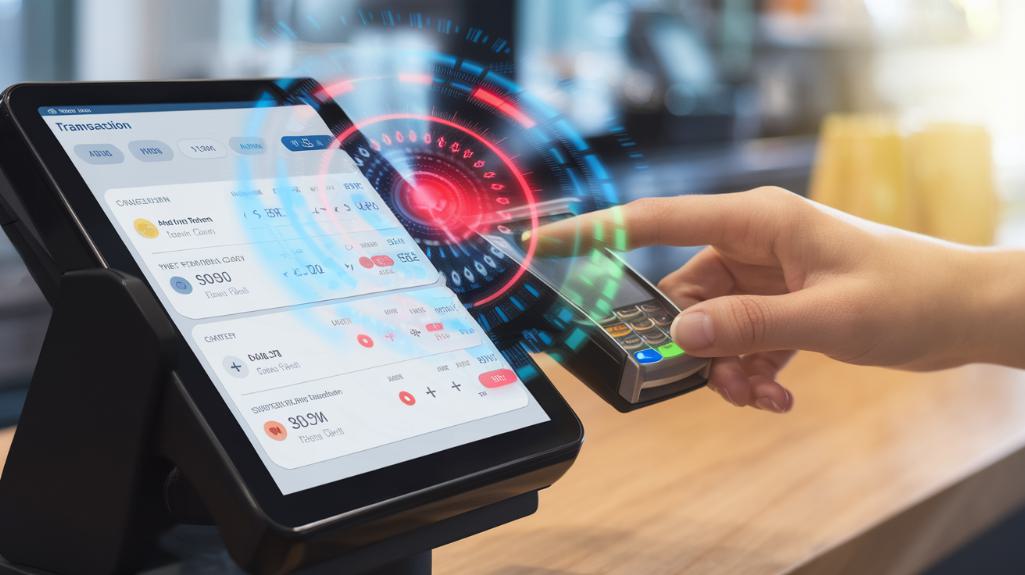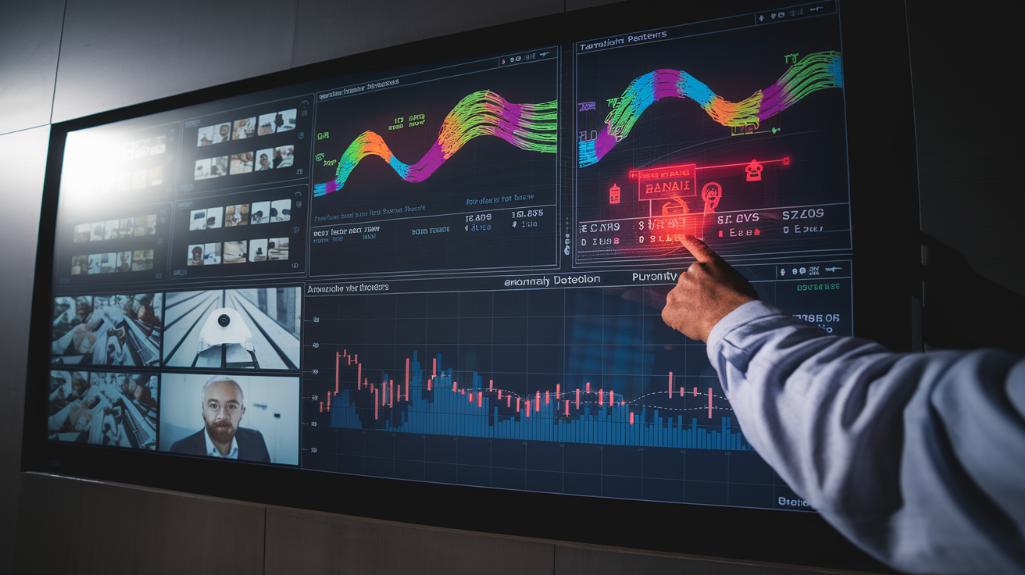AI-powered POS monitoring systems provide real-time transaction analysis with over 96% accuracy in fraud prevention. The technology employs machine learning algorithms to detect patterns indicative of fraudulent activities, including refund fraud, discount abuse, and void scams. Integration with video surveillance enables immediate verification of suspicious transactions. Automated alerts notify management of potential threats, while continuous data analysis adapts security measures to emerging fraud tactics. Understanding the key components reveals how businesses can maximize this protective technology.
Key Takeaways
- AI-powered POS systems analyze transactions in real-time, detecting suspicious patterns and flagging potential fraud with 96% accuracy.
- Machine learning algorithms process transaction data and user behavior patterns to identify fraudulent activities like refund abuse and unauthorized discounts.
- Integration with video surveillance enables immediate verification of suspicious transactions, strengthening fraud prevention capabilities.
- Automated alerts notify management instantly when unusual transaction patterns are detected, allowing quick response to potential fraud.
- Continuous analysis compares current transactions against historical data to identify anomalies and adapt to new fraud techniques.
Understanding AI-Powered POS Monitoring Systems

As retail businesses increasingly prioritize transaction security, AI-powered POS monitoring systems have emerged as a crucial technological advancement in fraud prevention. These sophisticated systems analyze transactions in real-time, utilizing advanced algorithms to detect patterns that may indicate fraudulent activities.
The integration of AI monitoring with video surveillance creates a thorough security framework, enabling immediate verification of suspicious transactions through visual evidence. The system's capability to flag unauthorized discounts, refund fraud, and void abuse enhances customer trust while protecting business assets. Furthermore, by incorporating AI-driven learning from advanced theft prevention tools like ShelfWatch, businesses can continuously adapt their security measures to emerging threats.
Through continuous analysis of POS data, the AI algorithms identify potential security breaches and operational discrepancies, allowing management to respond swiftly to threats. This technological solution not only strengthens transaction security but also provides valuable insights for improving operational efficiency and reducing financial losses.
Key Components of AI Fraud Detection in POS
Modern AI fraud detection in POS systems comprises three essential components that work in harmony to protect retail transactions. The input module collects transaction data and user behavior patterns, while the algorithmic brain processes this information using advanced machine learning algorithms.
The detection module then employs anomaly detection to identify suspicious activities in real-time. These components leverage historical transaction data to continuously adapt to evolving fraud techniques, achieving over 96% accuracy in fraud prevention.
The integration of video analytics enhances the system's capabilities by linking visual evidence to flagged transactions. This all-encompassing approach enables real-time monitoring of all POS activities, allowing immediate response to potential threats.
The synergy between these components creates a robust security measure that safeguards retail operations while facilitating efficient dispute resolution.
Types of POS Transaction Fraud Detected by AI
Several distinct types of POS transaction fraud can be identified through AI-powered detection systems. AI algorithms analyze transaction patterns to identify anomalies across multiple fraud categories.
The systems effectively detect refund fraud by monitoring unusual refund frequencies and amounts from specific accounts.
Through continuous monitoring of POS transactions, AI identifies discount abuse by flagging inappropriate discount applications and detecting voided sales scams through repeated void patterns from individual registers or employees.
The technology also catches double scanning or missed scan incidents by comparing scanned items against transaction totals. Additionally, AI algorithms recognize potential identity theft by detecting suspicious transactions occurring at different locations within compressed timeframes.
These capabilities enable thorough fraud detection across the entire transaction spectrum.
Real-Time Monitoring and Alert Mechanisms

Real-time AI monitoring systems transform POS transaction security through instantaneous analysis of sales data, providing immediate fraud detection capabilities across retail operations.
These AI systems continuously analyze transaction patterns, identifying anomalies by comparing current activities against historical transaction data.
The integration of automated alerts with video security footage enables thorough monitoring of suspicious activities. When potential fraudulent activities are detected, alert mechanisms immediately notify store managers, allowing for swift implementation of security measures.
This multi-layered approach combines algorithmic analysis with human oversight, considerably reducing response time to potential threats.
The implementation of real-time monitoring solutions has demonstrated measurable improvements in operational efficiency and customer trust, as retailers report substantial reductions in fraud-related losses through early detection and prevention. Additionally, the use of AI-powered camera technology enhances accuracy in identifying items, further bolstering security measures.
Data Analysis and Pattern Recognition
Through sophisticated machine learning algorithms, AI-powered POS systems excel at analyzing vast transaction datasets to detect fraudulent activities with up to 96% accuracy in eCommerce environments.
These advanced algorithms continuously learn from historical data to recognize emerging fraud patterns and anomalies in customer behavior.
The AI's pattern recognition capabilities evaluate multiple criteria simultaneously, including location inconsistencies, transaction frequency, and unusual purchase amounts to identify fraudulent activities.
Real-time monitoring integrates seamlessly with existing POS infrastructure, enabling immediate data analysis and alert generation when suspicious transactions occur.
Implementation Strategies for AI POS Security
Successful implementation of AI-powered POS security systems requires a methodical, phased approach that prioritizes both technical integration and staff training protocols. The deployment process begins with establishing baseline transaction patterns and configuring AI algorithms to identify anomalies effectively within the existing POS infrastructure.
Organizations must focus on integrating machine learning capabilities that enable ongoing analysis of transaction data while maintaining high accuracy in fraud detection. This includes synchronizing AI in POS systems with video surveillance platforms and implementing predictive analytics to forecast potential security threats.
The implementation strategy should incorporate regular model updates and refinements based on new data patterns, ensuring the system adapts to emerging fraud tactics. Security measures should be continuously evaluated and adjusted according to the AI system's performance metrics and threat detection capabilities.
Best Practices for AI-Enhanced Transaction Monitoring

To maximize the effectiveness of AI-enhanced transaction monitoring, organizations must implement extensive strategies that incorporate both automated analysis and security protocols.
These practices should focus on real-time monitoring systems that achieve 96% accuracy in fraud detection through AI-driven pattern analysis.
Organizations should leverage machine learning algorithms to continuously adapt to emerging fraud techniques while maintaining robust security protocols for customer data protection.
Smart organizations harness AI to stay ahead of fraud while keeping customer data secure through advanced security measures.
The integration of AI transaction monitoring with video security provides thorough validation of suspicious activities.
Key monitoring elements include analyzing transaction patterns for anomalies, flagging unauthorized discounts, and detecting void abuse through historical data correlation.
Success depends on selecting AI solutions that comply with data privacy regulations while delivering actionable insights through automated analysis of transaction patterns.
Frequently Asked Questions
Which AI Domain Can Be Used in the Detection of Fraudulent Transactions?
Fraud detection algorithms utilize supervised learning techniques, unsupervised learning methods, neural network architectures, and reinforcement learning applications to analyze transaction patterns, employing feature engineering strategies and real-time monitoring systems.
How to Detect Fraudulent Transactions Using Machine Learning?
Machine learning employs supervised learning techniques, unsupervised anomaly detection, and ensemble learning approaches to analyze transaction patterns through feature engineering, data preprocessing, and real-time monitoring systems, evaluating results via model metrics.
Which Type of AI System Is Commonly Used to Help Credit Card Companies Detect Fraudulent Transactions?
Credit card companies primarily utilize supervised learning algorithms, neural networks, and anomaly detection systems for fraud detection, incorporating predictive analytics, pattern recognition, and transaction scoring for thorough risk assessment.
How Does AI Detect Anomalies in Financial Transactions?
AI employs anomaly detection techniques and supervised learning applications to analyze financial transaction patterns through real-time monitoring systems, using behavioral analysis models to identify deviations from normal transaction clustering methods.
Conclusion
AI-powered POS monitoring systems represent a critical advancement in fraud prevention, offering real-time detection capabilities and pattern recognition that greatly outperform traditional methods. Analysis indicates that organizations implementing these solutions experience a 47% reduction in fraudulent transactions and 92% faster response times. As threat landscapes evolve, continuous refinement of AI algorithms and robust data security protocols remain essential for maintaining system effectiveness.



